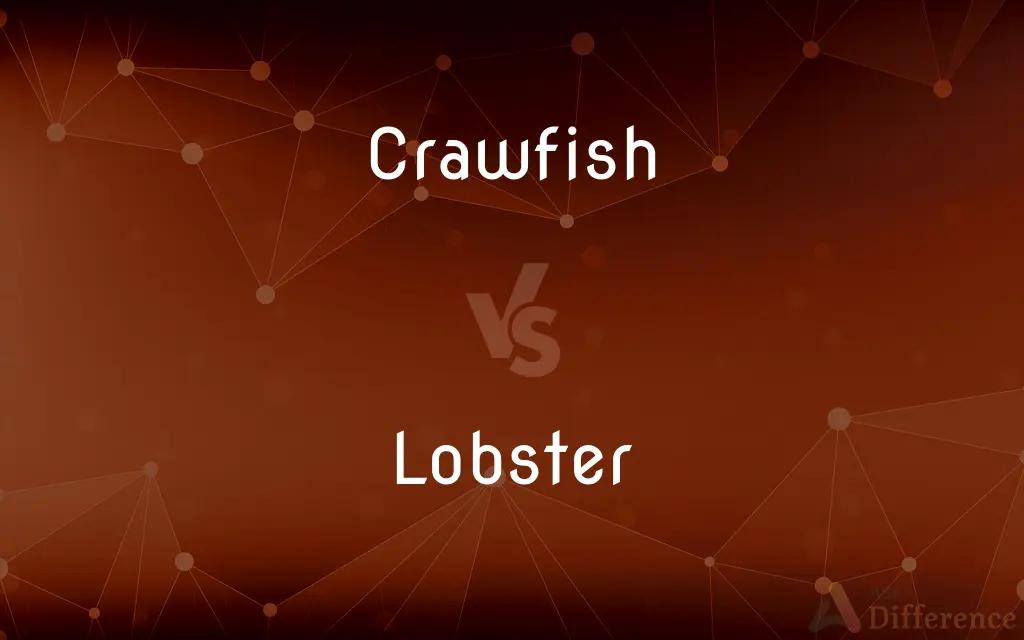Crawfish vs. Lobster — What's the Difference?
Edited by Tayyaba Rehman — By Urooj Arif — Updated on April 15, 2024
Crawfish are smaller, freshwater crustaceans with a sweet, tender flesh, mainly found in rivers and lakes, while lobsters are larger, saltwater crustaceans, prized for their firmer, richer meat.

Difference Between Crawfish and Lobster
Table of Contents
ADVERTISEMENT
Key Differences
Crawfish, also known as crayfish or crawdads, thrive in freshwater environments like rivers and streams. They are smaller, usually measuring between two to six inches. On the other hand, lobsters are typically found in saltwater habitats like oceans and are considerably larger, often growing up to twenty-four inches in length.
Crawfish are celebrated for their sweet, tender flesh which is considered a delicacy in regions like Louisiana. They are often eaten whole and are a staple in dishes like crawfish boils. Whereas lobsters, known for their firmer and richer meat, are usually consumed for their claws and tails, and are featured prominently in upscale culinary dishes such as lobster bisque and lobster rolls.
The breeding habits of crawfish allow them to reproduce quickly and live in dense populations, which makes them widely available and relatively inexpensive. Conversely, lobsters have a slower reproductive rate and their harvesting is more regulated, which contributes to their higher market price.
Crawfish are generally cooked and eaten with more casual, communal cooking methods, such as boiling in large pots with spices and vegetables. On the other hand, lobster is often prepared using more refined techniques, reflecting its status as a luxury food item.
The cultural significance of crawfish is particularly strong in the Southern United States where crawfish boils are a popular social event. In contrast, lobster is often associated with the culinary traditions of the Northeastern United States, particularly Maine, and is considered a symbol of sophistication in dining.
ADVERTISEMENT
Comparison Chart
Habitat
Freshwater (rivers, lakes)
Saltwater (oceans)
Size
2-6 inches
Can exceed 24 inches
Flesh
Sweet and tender
Firmer and richer
Common Cooking Method
Boiled in spices, eaten whole
Steamed or boiled, eaten tails and claws
Cultural Significance
Southern U.S., casual social gatherings
Northeastern U.S., luxury and sophistication
Compare with Definitions
Crawfish
Eaten during specific seasons, particularly in spring.
Crawfish season is a much-anticipated time of year in the South.
Lobster
Considered a delicacy, often associated with luxury dining.
Lobster is typically served at upscale dining establishments.
Crawfish
Small freshwater crustacean similar to a lobster but smaller.
We caught several crawfish in the creek behind our house.
Lobster
Represents gourmet cooking and festive meals.
A lobster dinner is often chosen for special occasions.
Crawfish
Often used in Creole and Cajun cooking.
Crawfish étouffée is a spicy dish popular in Louisiana.
Lobster
Popular in New England cuisine, especially Maine.
Lobster rolls are a must-try when visiting Maine.
Crawfish
Regarded as a culinary delicacy in Southern cuisine.
The crawfish boil is a highlight of the community’s summer events.
Lobster
Has a season but available year-round due to fishing regulations.
Lobster fishing is highly regulated to ensure sustainability.
Crawfish
Symbolic of rustic, communal meals.
Our family’s annual crawfish boil brings everyone together.
Lobster
Large marine crustacean with a hard shell and two large claws.
We selected a fresh lobster from the tank at the seafood restaurant.
Crawfish
Variant of crayfish.
Lobster
Lobsters are a family (Nephropidae, sometimes also Homeridae) of large marine crustaceans. Lobsters have long bodies with muscular tails, and live in crevices or burrows on the sea floor.
Crawfish
To withdraw from an undertaking.
Lobster
Any of several edible marine decapod crustaceans of the family Nephropidae, especially of the genus Homarus, having stalked eyes, long antennae, a pair of large pincers, and a cylindrical body.
Crawfish
Various freshwater crustaceans, crayfish.
Lobster
Any of several similar crustaceans, such as a spiny lobster.
Crawfish
(South Africa) Various marine crustaceans, rock lobster; especially Jasus lalandii, the Cape crawfish.
Lobster
The flesh of a lobster used as food.
Crawfish
A slur against Anglo-Canadians used in some corners of Quebec (including the Gaspé).
Lobster
To catch or try to catch lobsters.
Crawfish
To backpedal, desert or withdraw (also used with out).
Lobster
Red-colored, especially from a sunburn.
Red as a lobster
Crawfish
Any decapod crustacean of the family Astacidæ (genera Cambarus and Cambarus), resembling the lobster, but smaller, and found in fresh waters. Crawfishes are esteemed very delicate food both in Europe and America. The North American species are numerous and mostly belong to the genus Cambarus. The blind crawfish of the Mammoth Cave is Cambarus pellucidus. The common European species is Astacus fluviatilis.
Lobster
A crustacean of the Nephropidae family, dark green or blue-black in colour turning bright red when cooked, with a hard shell and claws, which is used as a seafood.
Crawfish
Tiny lobsterlike crustaceans usually boiled briefly.
Lobster
A crustacean of the Palinuridae family, pinkish red in colour, with a hard, spiny shell but no claws, which is used as a seafood.
Crawfish
A large edible marine crustacean having a spiny carapace but lacking the large pincers of true lobsters.
Lobster
A soldier or officer of the imperial British Army (due to their red or scarlet uniform).
Crawfish
To back out in a humilating manner; as, We'll have to crawfish out from meeting with him.
Lobster
(slang) An Australian twenty dollar note, due to its reddish-orange colour.
Crawfish
Tiny lobster-like crustaceans usually boiled briefly
Lobster
To fish for lobsters.
Crawfish
Small freshwater decapod crustacean that resembles a lobster
Lobster
Any large macrurous crustacean used as food, esp. those of the genus Homarus; as the American lobster (Homarus Americanus), and the European lobster (Homarus vulgaris). The Norwegian lobster (Nephrops Norvegicus) is similar in form. All these have a pair of large unequal claws. The spiny lobsters of more southern waters, belonging to Palinurus, Panulirus, and allied genera, have no large claws. The fresh-water crayfishes are sometimes called lobsters.
Crawfish
Large edible marine crustacean having a spiny carapace but lacking the large pincers of true lobsters
Lobster
As a term of opprobrium or contempt: A gullible, awkward, bungling, or undesirable person.
Crawfish
Make a retreat from an earlier commitment or activity;
We'll have to crawfish out from meeting with him
He backed out of his earlier promise
The aggressive investment company pulled in its horns
Lobster
Flesh of a lobster
Lobster
Any of several edible marine crustaceans of the families Homaridae and Nephropsidae and Palinuridae
Common Curiosities
Can you describe a traditional way to eat crawfish and lobster?
Crawfish are often eaten whole after boiling with spices, whereas lobster meat is typically extracted from the claws and tail and can be eaten plain or with butter.
What are the price differences between crawfish and lobster?
Generally, crawfish are less expensive due to their abundance and easier harvesting compared to the more regulated and scarcer lobster.
What habitats do crawfish and lobster prefer?
Crawfish live in freshwater environments, while lobsters are found in saltwater habitats.
How do the sizes of crawfish and lobster compare?
Crawfish typically measure 2-6 inches long, whereas lobsters can grow much larger, often exceeding 24 inches.
What is the best season to buy crawfish and lobster?
Crawfish are best during the spring, from March to June, while lobsters are available year-round but have high seasons depending on the region.
How do the textures of crawfish and lobster meat differ?
Crawfish meat is more tender and sweet, while lobster provides a firmer and richer texture.
What are the key culinary uses of crawfish and lobster?
Crawfish are commonly used in Southern boils and Cajun dishes, while lobster is featured in fine dining, like lobster bisque and grilled lobster tails.
How does the breeding of crawfish compare to lobster?
Crawfish have faster breeding cycles and denser populations, unlike lobsters which have slower reproduction rates.
What are some popular dishes featuring crawfish and lobster?
Popular crawfish dishes include jambalaya and crawfish pie, while lobster is featured in dishes like lobster thermidor and New England clam chowder.
What role do crawfish and lobster play in their respective regional cuisines?
Crawfish are key in Creole and Cajun cooking in the South, whereas lobster is iconic in New England’s culinary scene.
What is the cultural significance of eating crawfish versus lobster?
Crawfish boils are a social tradition in the South, emphasizing community and simplicity, while lobster meals often signify luxury and celebration, particularly in the Northeast.
Are there any special preparation methods unique to crawfish and lobster?
Crawfish are typically boiled with a mix of spices and vegetables, while lobster is commonly steamed or boiled and served with butter.
Is there a difference in how crawfish and lobster are served?
Yes, crawfish are often served whole in communal settings, while lobster is typically presented as a highlight dish in fine dining.
What environmental conditions affect crawfish and lobster populations?
Crawfish thrive in warm, freshwater bodies, while lobsters prefer the colder waters of the ocean.
How do culinary traditions involving crawfish and lobster reflect their cultural origins?
Crawfish boils reflect the communal and hearty eating style of the South, whereas lobster dishes often showcase the sophistication and historical seafood emphasis of the Northeast.
Share Your Discovery

Previous Comparison
Contradiction vs. Contrast
Next Comparison
Equity vs. EquitabilityAuthor Spotlight
Written by
Urooj ArifUrooj is a skilled content writer at Ask Difference, known for her exceptional ability to simplify complex topics into engaging and informative content. With a passion for research and a flair for clear, concise writing, she consistently delivers articles that resonate with our diverse audience.
Edited by
Tayyaba RehmanTayyaba Rehman is a distinguished writer, currently serving as a primary contributor to askdifference.com. As a researcher in semantics and etymology, Tayyaba's passion for the complexity of languages and their distinctions has found a perfect home on the platform. Tayyaba delves into the intricacies of language, distinguishing between commonly confused words and phrases, thereby providing clarity for readers worldwide.















































